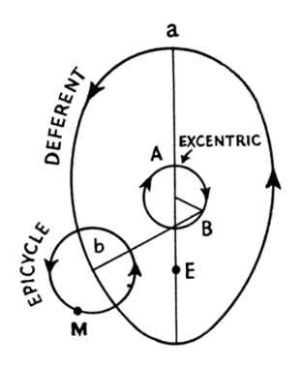The Sleepwalkers (30 page)
Authors: Arthur Koestler


These,
however,
were
not
the
only
irregularities
in
the
planetary
motions.
There
was
yet
another
scandal,
due
(as
we
today
know)
to
the
fact
that
their
orbits
are
not
circular,
but
elliptic,
that
is,
oval-shaped;
they
"bulge".
To
do
away
with
this
anomaly,
another
device
was
brought
in,
called
a
"movable
eccentric":
the
hub
of
the
Big
Wheel
no
longer
coincided
with
the
earth,
but
moved
on
a
small
circle
in
the
vicinity
of
the
earth;
and
in
this
manner
a
suitably
eccentric,
i.e.
"bulgy"
orbit,
was
produced.
†
____________________
* | At |
† | The |

Egg-shaped
Orbit
of
Mercury,
according
to
Ptolemy:
E
=
Earth;
M
=
Mercury.
In
the
figure
above,
the
hub
of
the
Big
Wheel
moves
clockwise
on
the
small
circle,
from
A
to
B;
the
point
on
the
rim
from
which
the
cabin
is
suspended
moves
anti-clockwise
in
an
egg-shaped
curve
from
a
to
b;
and
the
cabin
spins
round
the
final
epicycle.
But
this
was
not
enough;
in
the
case
of
some
recalcitrant
planets
it
was
found
necessary
to
suspend
a
second
cabin
from
the
cabin
suspended
on
the
Big
Wheel,
with
a
different
radius
and
a
different
speed;
and
then
a
third,
fourth
and
fifth,
until
the
passenger
in
the
ultimate
cabin
did
indeed
describe
a
trajectory
more
or
less
conforming
to
the
one
he
was
meant
to
describe.
By
the
time
the
Ptolemaic
system
was
perfected,
the
seven
passengers,
sun,
moon
and
five
planets,
needed
a
machinery
of
not
less
than
thirty-nine
wheels
to
move
through
the
sky;
the
outermost
wheel,
which
carried
the
fixed
stars,
made
the
number
an
even
forty.
This
system
was
still
the
only
one
recognized
by
academic
science
in
Milton's
day
–
and
was
caricatured
by
him
in
a
famous
passage
of
Paradise
Lost
:
From
man or angel the great Architect
Did wisely to conceal, and not
divulge,
His secret to be scanned by them who ought
Rather
admire; or, if they list to try
Conjecture, he his fabric of the
Heavens
Hath
left to their disputes, perhaps to move
His laughter at their
quaint opinions wide
Hereafter, when they come to model Heaven
And
calculate the stars, how they will wield
The mighty frame, how
build, unbuild, contrive
To save appearances, how gird the
sphere
With centric and eccentric scribbled o'er,
Cycle and
epicycle, orb in orb.
Alphonso
X
of
Castile,
called
the
Wise,
who
was
a
pious
man
and
a
great
patron
of
astronomy,
put
the
matter
more
succinctly.
When
he
was
initiated
into
the
Ptolemaic
system,
he
sighed:
'If
the
Lord
Almighty
had
consulted
me
before
embarking
upon
the
Creation,
I
should
have
recommended
something
simpler.'
3.
The Paradox
There
is
something
profoundly
distasteful
about
Ptolemy's
universe;
it
is
the
work
of
a
pedant
with
much
patience
and
little
originality,
doggedly
piling
"orb
in
orb".
All
the
basic
ideas
of
the
epicyclic
universe,
and
the
geometrical
tools
for
it,
had
been
perfected
by
his
predecessor,
Hipparchus;
but
Hipparchus
had
only
applied
them
to
the
construction
of
orbits
for
the
sun
and
moon.
Ptolemy
completed
the
unfinished
job,
without
contributing
any
idea
of
great
theoretical
value.
3
Hipparchus
flourished
around
125
B.C.,
more
than
a
century
after
Aristarchus;
and
Ptolemy
flourished
around
A.D.
150,
nearly
three
centuries
after
Hipparchus.
In
this
span
of
time,
nearly
equal
to
the
duration
of
the
Heroic
Age,
practically
no
progress
was
made.
The
landmarks
were
thinning
out,
and
were
soon
to
vanish
altogether
in
the
desert;
Ptolemy
was
the
last
great
astronomer
of
the
Alexandrian
School.
He
picked
up
the
threads
which
had
been
left
trailing
behind
Hipparchus,
and
completed
the
pattern
of
loop
entwined
in
loop.
It
was
a
monumental
and
depressing
tapestry,
the
product
of
tired
philosophy
and
decadent
science.
But
nothing
else
turned
up
to
replace
if
for
nearly
a
millennium
and
a
half.
Ptolemy
Almagest
4
,
remained
the
Bible
of
astronomy
until
the
beginning
of
the
seventeenth
century.